The abono joven gives you the perfect opportunity to discover the culture and history of Madrid and Spain without spending a dime more than your monthly fare. If you don’t know how it works just take a quick look at our previous blog about Advantages and discounts with the “abono joven”, or the youth card, where we explain in deep detail what it is, how to get it, and how to use it.
Places you can visit outside the Community of Madrid with the “abono joven”
1. Toledo
 Toledo was declared a World Heritage Site with a mixture of cultures, history, religions, and all styles in its monuments. Visiting it enhances your soul and mind. To go with the Abono Joven to Toledo you can take the Alsa bus number VAC-023, which leaves from the metro station Plaza Elíptica (lines 6 and 11) every 30 minutes and you can find a detailed schedule here.
Toledo was declared a World Heritage Site with a mixture of cultures, history, religions, and all styles in its monuments. Visiting it enhances your soul and mind. To go with the Abono Joven to Toledo you can take the Alsa bus number VAC-023, which leaves from the metro station Plaza Elíptica (lines 6 and 11) every 30 minutes and you can find a detailed schedule here.
2. Segovia
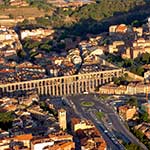 The old city of Segovia and its Roman aqueduct are on the World Heritage Sites list as well. It is an excellent starting point to tour and get close to the La Granja Palace or the Natural Park of the Hoces del Río Duratón. It has unique monuments that deserve a visit; a Jewish quarter, manor houses, panoramic views, and a green belt to have a good time walking in the sun.
The old city of Segovia and its Roman aqueduct are on the World Heritage Sites list as well. It is an excellent starting point to tour and get close to the La Granja Palace or the Natural Park of the Hoces del Río Duratón. It has unique monuments that deserve a visit; a Jewish quarter, manor houses, panoramic views, and a green belt to have a good time walking in the sun.
You can save money by taking the Cercanías until Cercedilla with the Abono Joven or the bus line and there take the regional to Segovia, which costs € 2.90 each way. For less than € 6 you get a chance to visit one of the most interesting places in the Community of Madrid!
If you prefer to go by bus, you can take the companies La Sepulvedana y AvanzaBus at the Intercambiador de Transportes de Moncloa for 4 euros, depending on the time. https://booking.avanzabus.com/web/index.php
3. Guadalajara
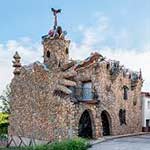 Guadalajara is the third largest city of the Community, behind Albacete and Talavera de la Reina. The city has several things to visit, such as the “Palacio del Infantado”, the “Panteón de la Condesa”, “Alcazar Real” and “Torreones”.
Guadalajara is the third largest city of the Community, behind Albacete and Talavera de la Reina. The city has several things to visit, such as the “Palacio del Infantado”, the “Panteón de la Condesa”, “Alcazar Real” and “Torreones”.
You can get there for free with the Abono Joven taking line C-2 Madrid – Guadalajara of the Cercanías or by bus from the Avenida de América (Avenida de América Metro). Find other routes here.
4. Cuenca
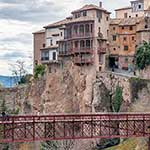 Declared a World Heritage Site (you can see a trend here, right?:), the upper city of Cuenca has one of the most beautiful views in Spain due to its hanging houses and the landscapes that surround it.
Declared a World Heritage Site (you can see a trend here, right?:), the upper city of Cuenca has one of the most beautiful views in Spain due to its hanging houses and the landscapes that surround it.
The most interesting things to see in Cuenca are the above-mentioned hanging houses, “Casas Colgadas”, which is a symbol of the city, and “Las caras de buéndia”, a series of faces carved in stone in the middle of nature. Also, the Hola Magazine has less known wonderful natural places to recommend in Cuenca.
Here you will find the different routes for public transport to Cuenca from Madrid.
Places you can visit inside the Community of Madrid with the “abono joven”
5. Aranjuez
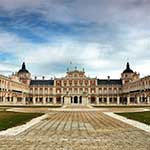 Aranjuez has been one of the Royal Sites of the Crown of Spain, since 1560 when Felipe II made it a Royal hunting residence. It is located south of the capital and is crossed by the rivers Tajo and Jarama. If you decide to go, you’re guaranteed a calm visit, focusing on the Royal Palace, its gardens (of the Island, of the Prince, of the Parterre, of Isabel II), and different fountains. While there you can also hop on a small tourist train that will take you a bit further from the city center to see bigger parks that provide lots of shade in the summertime.
Aranjuez has been one of the Royal Sites of the Crown of Spain, since 1560 when Felipe II made it a Royal hunting residence. It is located south of the capital and is crossed by the rivers Tajo and Jarama. If you decide to go, you’re guaranteed a calm visit, focusing on the Royal Palace, its gardens (of the Island, of the Prince, of the Parterre, of Isabel II), and different fountains. While there you can also hop on a small tourist train that will take you a bit further from the city center to see bigger parks that provide lots of shade in the summertime.
You can get to Aranjuez by Cercanías taking line C3 at Atocha Station or the bus line 423 from the South Station and Legazpi Square, on the Paseo del Molino.
6. Alcalá de Henares
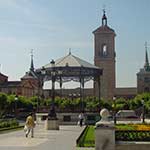 Alcalá de Henares has received a World Heritage City status in 1998. It is located to the East and is the third most populated municipality in the Community of Madrid. It is the birthplace of Cervantes and while there you simply have to visit Plaza de Cervantes, Corral de Comedias, Cathedral of the Saints Children, and Archbishop’s Palace.
Alcalá de Henares has received a World Heritage City status in 1998. It is located to the East and is the third most populated municipality in the Community of Madrid. It is the birthplace of Cervantes and while there you simply have to visit Plaza de Cervantes, Corral de Comedias, Cathedral of the Saints Children, and Archbishop’s Palace.
Using Abono Joven you can get there by Cercanías from the Atocha Station with line C2.
7. San Lorenzo de El Escorial
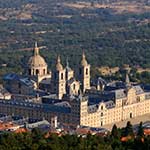 San Lorenzo de El Escorial was a real summer residence halfway between Madrid and La Granja de San Ildefonso. It was founded in the time of Carlos III and houses the Monastery of San Lorenzo de El Escorial and the Royal Site of the same name. Like many of the places on this list, it was declared World Heritage by Unesco, in 1984. It presents a large number of monuments of that time, which today have been reconverted giving place to a city full of charm, cultural atmosphere, and leisure options.
San Lorenzo de El Escorial was a real summer residence halfway between Madrid and La Granja de San Ildefonso. It was founded in the time of Carlos III and houses the Monastery of San Lorenzo de El Escorial and the Royal Site of the same name. Like many of the places on this list, it was declared World Heritage by Unesco, in 1984. It presents a large number of monuments of that time, which today have been reconverted giving place to a city full of charm, cultural atmosphere, and leisure options.
To get there you can take the Cercanías line C8A from Chamartín Station or the line bus 661 or 664 from Las Rozas for free with the Abono Joven.
8. Buitrago de Loyoza
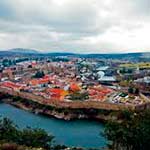 Buitrago de Loyoza has a beautiful view of the formations created on its way through the Lozoya River. If you want to relax amongst the breathtaking mountain views, Lozoya will have what you need. Its unbeatable scenery hides a village with the largest natural pool in Spain, sports courts, children’s areas, and a botanical garden in the Recreational Area of Riosequillo. To get to Buitrago de Loyoza you’ll have to take the bus 191 from the Castellana district of Madrid.
Buitrago de Loyoza has a beautiful view of the formations created on its way through the Lozoya River. If you want to relax amongst the breathtaking mountain views, Lozoya will have what you need. Its unbeatable scenery hides a village with the largest natural pool in Spain, sports courts, children’s areas, and a botanical garden in the Recreational Area of Riosequillo. To get to Buitrago de Loyoza you’ll have to take the bus 191 from the Castellana district of Madrid.
9. Chinchón
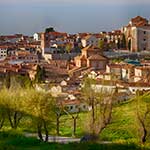 The City of Chinchón is one of the most beautiful cities in Spain with its multicolor landscape, with clusters of houses grouped in hills that shelter its singular Plaza Mayor. It has a wide variety of tourist attractions, such as the Church Ntra. Sra. De la Asunción, the Clock Tower, the “Lope de Vega” Theater, the Monastery of the Agustinos (nowadays it hosts the Parador de Turismo), the Castle of the Counts, and the jewel of the region. To get to Chinchón you should take the bus line 337 from Conde Casal.
The City of Chinchón is one of the most beautiful cities in Spain with its multicolor landscape, with clusters of houses grouped in hills that shelter its singular Plaza Mayor. It has a wide variety of tourist attractions, such as the Church Ntra. Sra. De la Asunción, the Clock Tower, the “Lope de Vega” Theater, the Monastery of the Agustinos (nowadays it hosts the Parador de Turismo), the Castle of the Counts, and the jewel of the region. To get to Chinchón you should take the bus line 337 from Conde Casal.
10. Cercedilla
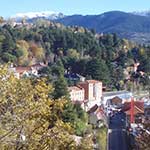 Cercedilla is eminently mountainous, with a climate of the continental type, marked by very pleasant summers and cold and wet winters, along with a good cultural offer, leisure, and adventure, make up an ideal municipality to enjoy free time, a vacation or a weekend getaway. You can take the Cercanías line C8 from Chamartín Station.
Cercedilla is eminently mountainous, with a climate of the continental type, marked by very pleasant summers and cold and wet winters, along with a good cultural offer, leisure, and adventure, make up an ideal municipality to enjoy free time, a vacation or a weekend getaway. You can take the Cercanías line C8 from Chamartín Station.
11. Patones
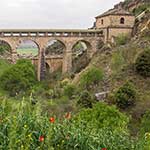 Patones is a beautiful town on a small mountain. The charm of Patones resides in its picturesque aspect of paved streets, with big slopes and houses of stone and slate, being one of the most representative samples of black architecture of the Community of Madrid. Bus lines 197 and 197A from Plaza de Castilla metro station are available for you to get to Patones.
Patones is a beautiful town on a small mountain. The charm of Patones resides in its picturesque aspect of paved streets, with big slopes and houses of stone and slate, being one of the most representative samples of black architecture of the Community of Madrid. Bus lines 197 and 197A from Plaza de Castilla metro station are available for you to get to Patones.
12. Manzanares el Real
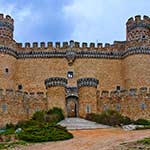 Manzanares el Real contains one of the best-preserved medieval fortresses in Spain: the Castillo de los Mendoza, in Manzanares El Real. It is one of the most emblematic towns of the Sierra Madrileña and has a large tourist influx throughout the year. The main monuments and places of interest in the municipality of Manzanares el Real are the ruins of the Old, the eighteenth-century bridge, and more! Get there by bus line 724 from Plaza Castilla.
Manzanares el Real contains one of the best-preserved medieval fortresses in Spain: the Castillo de los Mendoza, in Manzanares El Real. It is one of the most emblematic towns of the Sierra Madrileña and has a large tourist influx throughout the year. The main monuments and places of interest in the municipality of Manzanares el Real are the ruins of the Old, the eighteenth-century bridge, and more! Get there by bus line 724 from Plaza Castilla.
13. Rascafrías
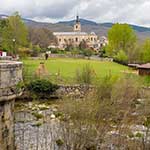 Rascafrías has a natural landscape ideal for those who love nature, also it has the well-known Natural Pools of Las Presillas, in Rascafría. You can visit the Town Hall, the Old Postas House, the church of San Andrés Apóstol, the Casona, the Belgian sawmills, the Rascafría Natural Park, and more. The bus line to get to Rascafrías from Plaza Castilla metro station is 194. Also, you can get through Cercanías lines C8b and C9, with a transfer between the two.
Rascafrías has a natural landscape ideal for those who love nature, also it has the well-known Natural Pools of Las Presillas, in Rascafría. You can visit the Town Hall, the Old Postas House, the church of San Andrés Apóstol, the Casona, the Belgian sawmills, the Rascafría Natural Park, and more. The bus line to get to Rascafrías from Plaza Castilla metro station is 194. Also, you can get through Cercanías lines C8b and C9, with a transfer between the two.
Stay up to date with our blog regularly, where we talk about enjoying Madrid, improving your Spanish, and teaching English through our leading TEFL course in Spain.


Comments are closed.